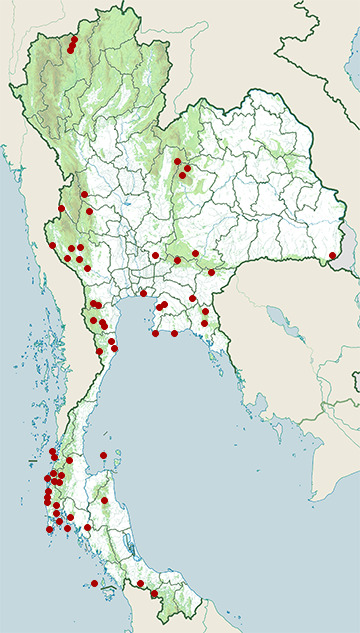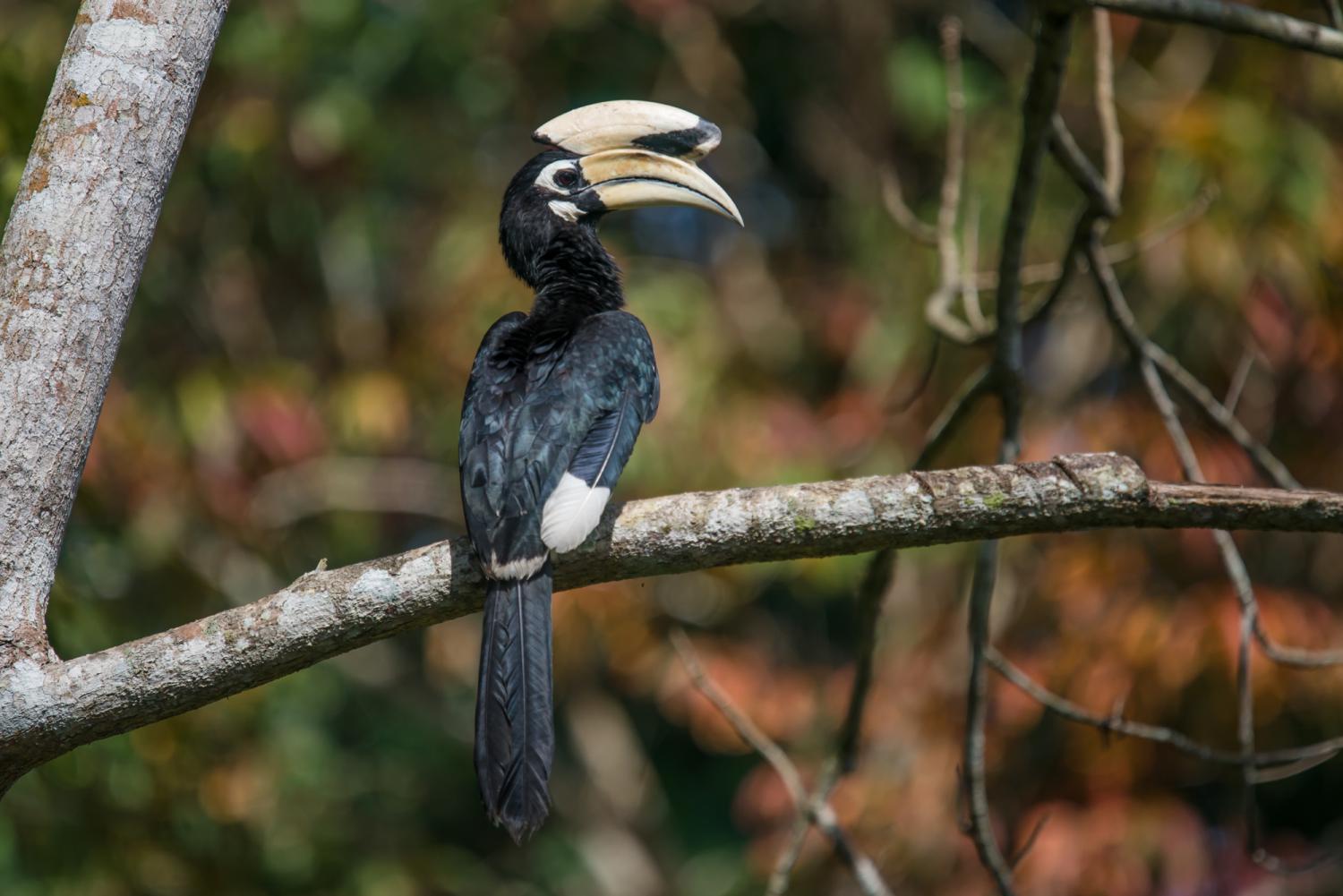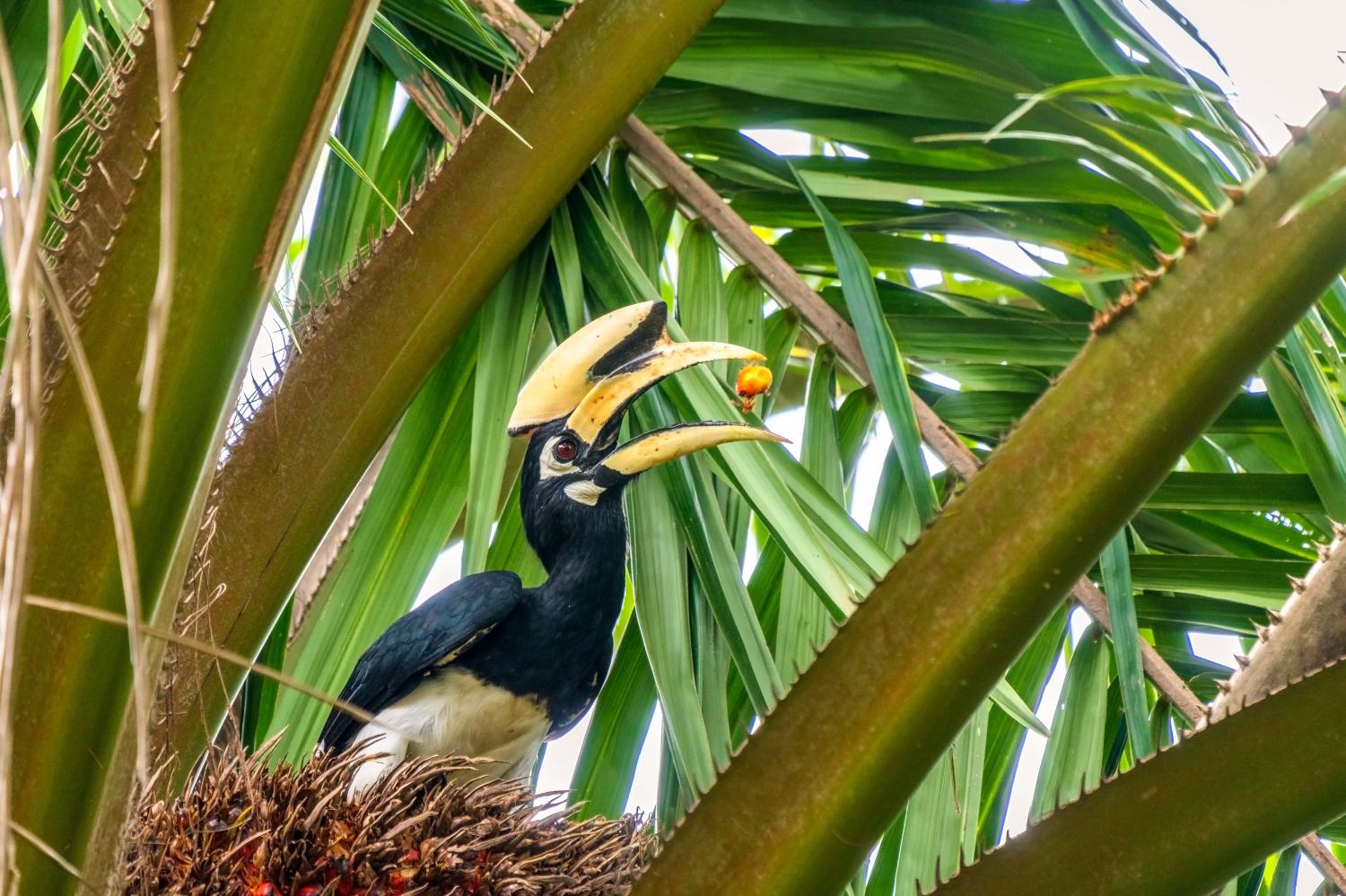Species of Thailand
Oriental pied hornbill
Anthracoceros albirostris
George Shaw & Frederick Polydore Nodder, 1807
In Thai: นกแก๊ก, นกแกง
The oriental pied hornbill (Anthracoceros albirostris) is an Indo-Malayan pied hornbill, a large canopy-dwelling bird belonging to the family Bucerotidae. Two other common names for this species are sunda pied hornbill (convexus) and Malaysian pied hornbill.
The species is considered to be among the smallest and most common of the Asian hornbills. It has the largest distribution in the genus and is found in the Indian Subcontinent and throughout Southeast Asia. Its natural habitat is subtropical or tropical moist lowland forests. The oriental pied hornbill's diet includes fruit, insects, shellfish, small reptiles and, sometimes, small mammals and birds including their eggs.
Taxonomy
The Oriental hornbill, of the family Bucerotidae, belongs to the genus Anthracoceros, which consists of five species. Species in this genus are divided into two groups, Indo-Malayan pied hornbills and black hornbills. A. albirostris is grouped under the Indo-Malayan pied hornbills, based on plumage similarities, along with the Indian pied hornbill (A. coronatus) and the Palawan hornbill (A. marchei). The black hornbills include A. malayanus and A. montani.
A. albirostris can be further categorized into two subspecies, A. a. albirostris and A. a. convexus.
Description
The oriental pied hornbill is a medium size frugivore with a head-to-tail length of 55–60 cm and a wingspan of 23–36 cm. The bill measures 19 cm for males and 16 cm for females. It can weigh between 600 g and 1, 050 g, averaging 900 g for males and 875 g for females. The plumage of the head, neck, back, wings and upper breast is black with a slight green sheen. The tail is black with white tips on all the feathers except the central feathers (rectories). The plumage of their lower breast, lower abdomen, thighs, under-wing and all the tips of the wings except the three basal secondaries and two outer primaries is white, as is the circumorbital skin around the eyes and on the throat skin. A blue tinge can sometimes be noticed on the throat of adults. Casques of mature A. albirostri are laterally flattened “cylinders”, which may form a protruding horn. Males and females are similar in coloration. Males can be distinguished from females by their larger body size, yellow bill, which has a black base, and bright red eyes. Females have a slightly smaller body size, a yellow bill and casque with a partly black, browned patched mandible, and grayish-brown eyes. Juvenile A. albirostris resemble the adults, but have an undeveloped casque and a smaller bill. Their black plumage lacks the green gloss found on adults.
The calls of the oriental pied hornbill have been described as crowlike sounds, braying sounds or harsh crackles and screeches
Distribution and habitat
The oriental pied hornbill is found in the Indian Subcontinent and Southeast Asia, ranging across Bangladesh, Bhutan, Brunei, Cambodia, Eastern and Northern India, Indonesia, Laos, North peninsular Malaysia, Myanmar, Nepal, Singapore, Thailand, Tibet, Vietnam and the Sunda shelf islands. Its natural habitat is subtropical or tropical moist lowland forests. Within these regions, A. albirostris occupies various habitat types, which include dry and semi-evergreen forests, dry and moist deciduous forests, subtropical broadleaf forests, secondary forests, plantations and woodlands.
Feeding ecology
Hornbills are predominantly frugivores. The oriental pied hornbill's diet consists of wild fruits such as figs (Ficus spp.), melanoxylon berries, rambutans, palm fruit, papaya and fruits of liana plants. It will also take large insects (grasshoppers), small birds (finches) small reptiles (lizards and snakes), amphibians such as frogs, and fish. Its diet differs slightly between the breeding and non-breeding season. During the non-breeding season, oriental pied hornbills feed more on non-fig fruit such as small sized berries, drupes, arillate capsules and lianas (woody vines), however the availability of these food items is lower in the breeding season, which suggests that the species increases its habitat range during that time. They also tend to feed in flocks during the non breeding season. When foraging for food, they tend to select a few common species of fruit trees. They show a preference towards trees belonging to the families Annonaceae, Meliaceae and Myristicaceae. Other target species include Rourea minor, Polyalthia viridis, Cinnamomum subavenium, Trichosanthes tricuspidata, and many others. Feeding on a diversity of fruits ensure that nutritional requirements are met. In the non-breeding season fruits that are selected for are generally sugar rich, while lipid-rich fruits and invertebrates are highly selected for during the breeding season.
Oriental pied hornbills are important large seed dispersers, promoting seedling recruitment by translocating the seeds of the fruits they feed on. Few other bird species outside the hornbill family have large enough gape widths to allow them to disperse large seeds to special microsites or open habitats. Seed dispersal behavior of hornbills thus helps shape forest communities, and disruption of this animal-plant interaction may have significant impacts on the reshaping of forest communities.
Reproduction
Hornbills are generally monogamous and breed between January and June; oriental pied hornbills typically commence breeding in February. This coincides with the onset of rain depending on geographic location, and peak abundance of fruit.
Hornbills are secondary cavity nesters, meaning that they typically do not excavate their own nesting sites but use those created by other birds or by branches breaking off. Because hornbills rely on pre-excavated cavities, selection of suitable nest-sites within their environment has major impacts on breeding success. When females have selected and entered their nest, they seal the cavity with a mixture of saliva, mud, fruit, droppings and tree bark, leaving only a small opening through which food may be passed in. The male forages for the female and chicks, and the female feeds the nestlings. Chicks remain inside the nest with the female for several months until there are ready to fledge. Oriental pied hornbills have shown to return to their previous nest for subsequent nesting seasons.
Nest selection
Hornbills select nest sites based on the availability and type of fruiting trees, as well as on the availability and quality of nest site cavities in their particular habitat. Some oriental pied hornbills have demonstrated tree species preferences for nest site selection. In Rajaji National Park in India, oriental pied hornbills nest in a variety of tree species such as Bombax ceiba, Careya arborea, Cordia myxa, Lagerstroemia parviflora, Mitragyma parviflora, Terminalia belerica, Shorea robusta, and Syzigium cumini.
The main difference in the structural characteristics of nest cavities between hornbill species is cavity size, which is highly correlated with body size. Cavities preferred by the oriental pied hornbill are elongate and may be located at a height between 1–18 m or more. Cavity entrance shape is rounder than for other hornbills. Oriental pied hornbills tend to select nesting sites in close proximity to rivers or other bodies of water. Compared to other hornbill species such as the great pied hornbill and wreathed hornbill, the oriental pied hornbill demonstrates tolerance to disturbed habitats. Nests have been found in disturbed, secondary forest areas such as plantations, degraded forests and logging sites, while other hornbill species tend to avoid such sites. Nests found in human disturbed areas are however often unsuccessful or abandoned; in general, hornbills prefer undisturbed forest areas.
Because oriental pied hornbills inhabit various habitats, nest structural characteristics may vary from one habitat to another, and may also vary between hornbill species, which have overlapping habitats. Habitat overlap among hornbill species may lead to intra & inter specific competition, whereby hornbills compete for limited nest-sites. Competition for nest-sites with other species such as squirrels, lizard and other cavity nesting birds can also have critical impacts on breeding success.
Conservation
The species has an extremely wide range and appears to be the hornbill species most adaptable to habitat alterations; it is thus not currently considered to be threatened. What declines in oriental pied hornbill population have been reported are mainly caused by legal and illegal logging, which decreases the availability of suitable nesting and fruiting trees. A. albirostris are subject to some hunting pressure (casques are sold as souvenirs) and are popular as pets in some areas. It has also been noted that the species has been almost completely extirpated from southern China.
Conservation efforts such as captive breeding and reintroduction are currently in practice. Breeding in captivity of has so far shown a low success rate. In some areas such as Cambodia, artificial nests made from iron tanks are installed in nesting sites to provide alternative nesting sites for hornbills when natural nest-site availability is low and to aid reintroduction.
This article uses material from Wikipedia released under the Creative Commons Attribution-Share-Alike Licence 3.0. Eventual photos shown in this page may or may not be from Wikipedia, please see the license details for photos in photo by-lines.
Category / Seasonal Status
BCST Category: Recorded in an apparently wild state within the last 50 years
BCST Seasonal status: Resident or presumed resident
Scientific classification
- Kingdom
- Animalia
- Phylum
- Chordata
- Class
- Aves
- Order
- Bucerotiformes
- Family
- Bucerotidae
- Genus
- Anthracoceros
- Species
- Anthracoceros albirostris
Common names
- Thai: นกแก๊ก, นกแกง
Conservation status

Least Concern (IUCN3.1)
Photos
Please help us review the bird photos if wrong ones are used. We can be reached via our contact us page.
Range Map

- Ang Thong National Marine Park
- Ao Phang-Nga National Park
- Ban Bueng District, Chonburi
- Chaloem Phrakiat Thai Prachan National Park
- Chiang Dao District, Chiang Mai
- Chiang Dao Wildlife Sanctuary
- Erawan National Park
- Huai Kha Khaeng Wildlife Sanctuary
- Kaeng Krachan District, Phetchaburi
- Kaeng Krachan National Park
- Kaeng Krung National Park
- Khao Ang Rue Nai Wildlife Sanctuary
- Khao Khitchakut National Park
- Khao Laem Ya - Mu Ko Samet National Park
- Khao Lak - Lam Ru National Park
- Khao Luang National Park
- Khao Nam Khang National Park
- Khao Phra - Bang Khram Wildlife Sanctuary
- Khao Sam Roi Yot National Park
- Khao Soi Dao Wildlife Sanctuary
- Khao Sok National Park
- Khao Yai National Park
- Khlong Saeng Wildlife Sanctuary
- Khon San District, Chaiyaphum
- Khura Buri District, Phang Nga
- Ko Phayam
- Ko Phra Thong
- Ko Yao District, Phang Nga
- Kui Buri National Park
- Laem Son National Park
- Mae Wong National Park
- Mueang Krabi District, Krabi
- Mueang Phang Nga District, Phang Nga
- Mueang Phuket District, Phuket
- Nam Nao National Park
- Namtok Sam Lan National Park
- Ngao Waterfall National Park
- Pachee River Wildlife Sanctuary
- Pang Sida National Park
- Pha Daeng National Park
- Phi Phi Islands
- Phu Chong Na Yoi National Park
- Phu Khiao Wildlife Sanctuary
- Pran Buri District, Prachuap Khiri Khan
- Sai Yok National Park
- Sakaerat Environmental Research Station
- Salak Pra Wildlife Sanctuary
- Samae San Island
- Samut Prakan Province
- San Kala Khiri National Park
- Si Racha District, Chonburi
- Si Sawat District, Kanchanaburi
- Sri Nakarin Dam National Park
- Sri Phang Nga National Park
- Takua Pa District, Phang Nga
- Tarutao National Marine Park
- Tha Yang District, Phetchaburi
- Thai Mueang District, Phang Nga
- Thong Pha Phum National Park
- Thung Yai Naresuan Wildlife Sanctuary





